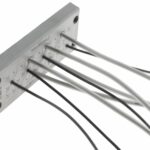
Cable entry holes are necessary to feed important cables and wiring through a wall, but these holes must be sealed properly for safety reasons. You can use several different products and methods to seal these entry holes, and you’ll want to be familiar with the most effective methods. How do you seal a cable entry hole? Learn the best ways to seal a hole around a cable and why sealing cable entry holes is critical.
Table of Contents
Why Is It Important to Seal Cable Entry Holes?
It may seem like a small gap, but it’s vital that you seal a cable going through a wall. You may be surprised to learn what can get through them. Cable entry holes can also allow entry to things like gas, water, rodents, hydrocarbons and volatile organic compounds (VOCs) such as hydrogen sulfide, methane, chlorine gases and petroleum products. When exposed to an electrical ignition source, VOCs can present an explosion risk.
Moisture and corrosive gases can travel through an unsealed cable entry hole, damaging critical components and equipment. In a humid environment, moisture is more likely to affect electrical components. When your cables and wiring are exposed to water, it can result in shocks, short circuits, damaged equipment and fires. Toxic gases can make their way through cable entry holes and harm people in the building.
Rodents like rats and mice must constantly gnaw on things to wear their teeth down, the same way humans cut their nails. Wires and cables are easy targets for them. They will chew away at the rubber covering your wires, leaving them exposed and hazardous. When mice and rats gnaw on cables, it can lead to malfunctioning equipment and electrical fires.

These are only some of the concerns you will address and problems you can avoid by sealing cable entry holes.
What Do You Need to Seal a Cable Entry Hole?
To get the job done properly, you will need the following tools:
- Cloth: You should clean the cables you work with. Dust and dirt can get trapped and create a bad seal. A thorough wipe-down with a cloth will avoid this.
- Protective gloves: When dealing with electrical equipment, it’s always best to wear protective gloves. They also prevent sealant or caulk from getting on your hands.
- Cable entry apparatus: Cable entry frames, plates, grommets, glands and boxes are used to secure your wires and seal their entry holes.
- Sealant: You may also need additional sealant. Duct seal putty is a non-corrosive and non-conductive cable entry sealing compound that blocks moisture, airflow and dust while protecting your cables.
- Tools: Drills and screwdrivers are needed to secure components.
5 Techniques for Sealing Cable Entry Holes
Understanding the different cable entry parts and what they are used for is essential to know how to seal cable entry holes. These are the most useful cable entry sealing parts that you need to be familiar with:
Using Cable Entry Plates
Plates are round or rectangular and can help you fit multiple cables through a single entry point. Rectangular or square-shaped plates connect cables to equipment and cable entry systems. Round entry plates are better suited for existing designs with threaded holes.
Instead of drilling holes for each cable, modern cable entry plates come in various sizes, with anywhere from four to 72 entries per plate. Many cable entry plates have a double membrane design to improve strain relief and offer better protection.
Using Cable Entry Boxes
How do you seal an outside wire? Cable boxes are among the best options for outside wires since they protect cables from environmental factors such as precipitation, UV exposure and fluctuating temperatures. They are resistant to UV light and water damage. Cable entry boxes provide an enclosure for cables and cable entry parts such as glands.
Cable entry boxes are available in different types for various applications. Some boxes include a self-sealing diaphragm, which makes them easier to use and reduces the time needed to install them. Others have threaded areas for mounting cable glands so you can customize your solution.
Using Cable Entry Grommets
Cable entry grommets are tubes of rubber or metal that help protect and seal cables. Many different types of grommets are available. For example, blind grommets don’t require a connector, while quickseal grommets make installation faster and easier. Other grommets allow multiple cables to pass through one entry point.
Using Cable Glands
One way to protect your cables from being damaged is with cable entry glands, also called cable connectors, cable strain relief, cable fitting or cord grips. Cable entry glands keep cables and wires safe. Sealing cable entry holes with glands is a reliable way of securing and protecting your cables, especially ones that stay plugged in at all times and require a safe and constant supply of electricity.
Different types of cable glands are suitable for different situations based on their benefits. Metal glands are best suited for chemical applications and food processing. They have excellent durability and resistance to heat and water. Synthetic glands are lightweight and resistant to chemicals, making them especially useful for instrumentation and telecommunications applications. Splittable cable glands are used for threaded or round entry holes in pre-terminated systems.
You can also choose specialty cable glands if you have a unique application. Specialty cable glands include those with pressure balance elements, firewall safety glands, electromagnetically shielded glands, solid insert cable glands and 90-degree wire glands.
Using Cable Entry Frames
Cable entry frames fit around cables and protect them from damage while attached to pieces of equipment. Splittable frames are mounted on enclosures and walls for extra strength and security. Cable entry frames come in various standard sizes to fit common connectors and are built to meet specific standards to ensure cables are protected in dangerous environments.
Browse Our Cable Entry System Solutions
Trust AerosUSA for all your cable entry solutions. We carry an extensive range of cable entry hole products to keep your cables and equipment safe. Our high-quality cable entry systems are made to last and help ensure your cables are secure and protected for a long time. Our products are designed for fast installation to reduce labor costs and to make them easy to install in locations requiring high flexibility. We offer insightful expertise, efficient service and a large inventory.
We offer an online library full of resources and information to help you find the right product, answer your questions and provide professional tips and advice. We are dedicated and confident in the work we do and the products we provide. Find out more about how we can help you by contacting us today.





